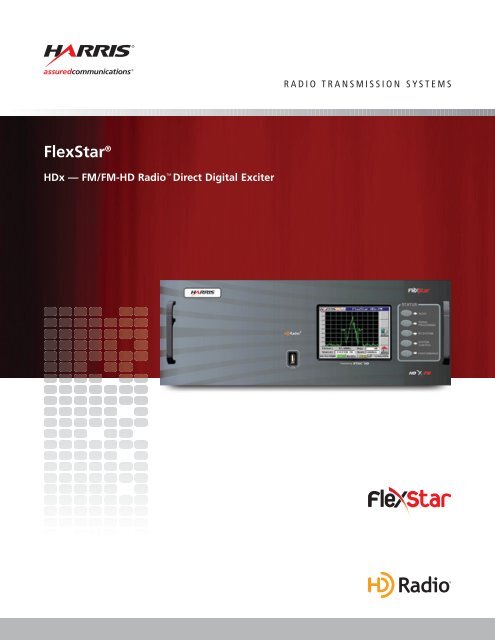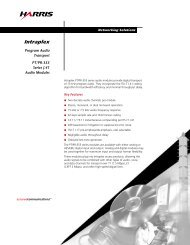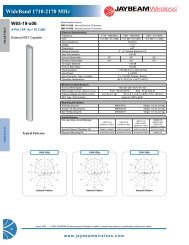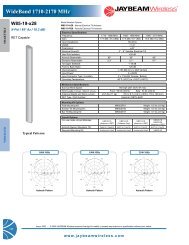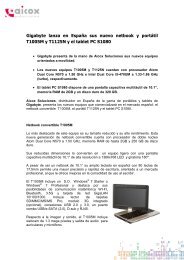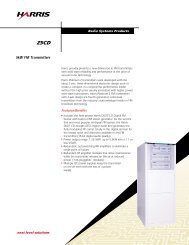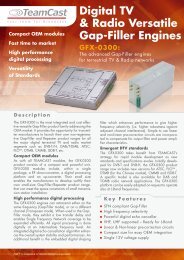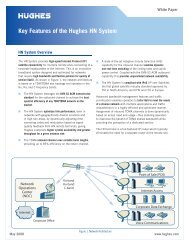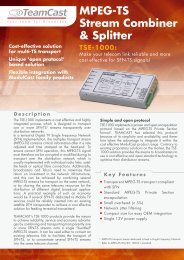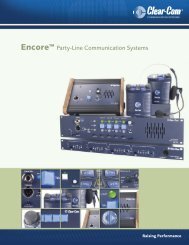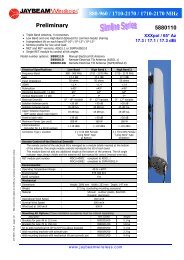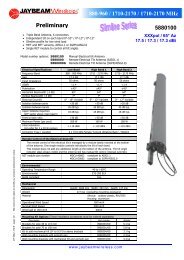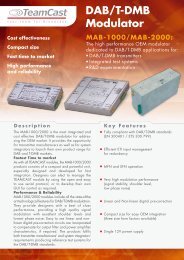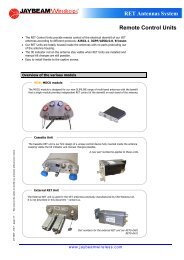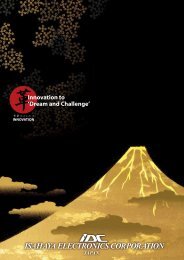FlexStar-HDx
FlexStar-HDx
FlexStar-HDx
Create successful ePaper yourself
Turn your PDF publications into a flip-book with our unique Google optimized e-Paper software.
RADIO TRANSMISSION SYSTEMS<br />
<strong>FlexStar</strong> ®<br />
<strong>HDx</strong> — FM/FM-HD Radio Direct Digital Exciter
<strong>FlexStar</strong> ®<br />
Make these Harris ® <strong>FlexStar</strong> ® exciter benefits yours:<br />
Investment security based on<br />
unrivaled digital experience<br />
HD Radio ® is not only a safe and wise<br />
investment — it's a whole new technology<br />
ballgame. As broadcasting's DTV and DAB<br />
(Eureka 147) transmission leader, Harris has<br />
developed a solid core competency backed<br />
by years of experience in the complex<br />
technical areas that are essential for<br />
maximum HD Radio ® performance. And<br />
we’ve put this expertise to the test by<br />
providing transmitters for every major HD Radio ®<br />
test, including multicasting, since the beginning.<br />
Exclusive pre-correction technology<br />
for significant cost savings<br />
Featuring Harris’ proprietary RTAC (Real-<br />
Time Adaptive Correction) pre-correction<br />
circuitry, <strong>FlexStar</strong> ® <strong>HDx</strong> enables transmitters<br />
to deliver linear amplification without the<br />
need for RF bandpass filters that cost up to<br />
$15,000. And this is only the beginning.<br />
Harris’ exclusive RTAC technology also<br />
increases efficiency for ongoing power<br />
savings – while comfortably exceeding the<br />
FCC’s RF mask requirements to prevent<br />
signal interference.<br />
Dual-output exciter<br />
in one compact package<br />
The <strong>FlexStar</strong> ® <strong>HDx</strong> is the world’s first and<br />
only dual-output exciter, designed to drive<br />
two FM/HD transmitters for improved<br />
performance and operating efficiency. Each<br />
output can provide both HD Radio ® and/or<br />
analog FM modulation so you can configure<br />
the system for your optimal combining<br />
method. When coupled with the <strong>FlexStar</strong> ®<br />
Boost-Pro, you can effortlessly drive dual<br />
transmitters and eliminate complex RFphasing<br />
hardware, reducing costly<br />
components and ongoing maintenance.<br />
The compact size of the <strong>FlexStar</strong> ® <strong>HDx</strong> also<br />
eliminates the need for a deep rack.<br />
A cost-effective and flexible<br />
migration path<br />
Not ready to go HD Radio ® but need a new<br />
transmitter? Purchase an HD Radio-ready<br />
transmitter with a <strong>FlexStar</strong> ® <strong>HDx</strong> analog<br />
exciter today, and add a Harris exporter and<br />
Exgine upgrade card when you wish to<br />
commence HD Radio ® operation. No other<br />
system provides a seamless upgrade path<br />
with the power of RTAC .<br />
Integrated Stereo, Dual SCA and<br />
RBDS generators<br />
A multitude of built-in features such as a<br />
digital stereo generator with adjustable<br />
composite limiter, two frequency agile SCA<br />
generators, and a static RBDS generator eliminate<br />
the need for costly outboard equipment.<br />
A complete end-to-end solution<br />
Only Harris can provide everything you need<br />
as you plan your transition to digital radio ...<br />
from source through consoles and studio,<br />
through STL, through transmission. And our<br />
systems team is available to help you put<br />
together the system that makes the most sense<br />
for your operation — now and in the future.
<strong>FlexStar</strong> ®<br />
Ultimate Performance and Flexibility<br />
From the leader in HD technology comes<br />
the most advanced HD Radio ® exciter ever<br />
invented. The <strong>FlexStar</strong> ® <strong>HDx</strong> brings HD<br />
Radio ® to the next level with performance<br />
that is unrivaled and key features that<br />
ensure your investment in HD pays off today<br />
and in the future.<br />
When it comes to one of the most critical<br />
components of your air chain, why gamble?<br />
Harris digital FM and HD Radio ® exciters<br />
have logged more hours in “real-time”<br />
broadcast use than all the others combined.<br />
Hour after hour, day after day, the <strong>FlexStar</strong> ®<br />
<strong>HDx</strong> exciter provides a digital signal of<br />
flawless integrity with complete technical<br />
and regulatory compliance for Harris tube<br />
and solid-state HD Radio ® transmitters. And<br />
<strong>HDx</strong> analog FM performance is unsurpassed<br />
in the industry.<br />
The exclusive Real-Time Adaptive<br />
Correction (RTAC ) incorporated in the<br />
<strong>FlexStar</strong> ® <strong>HDx</strong> exciter continuously monitors<br />
the output of your transmitter and any filter<br />
or multistation combiner, while it<br />
automatically adapts for system nonlinearities.<br />
This keeps your station well within FCC<br />
compliance and maximizes your coverage.<br />
Sustainable performance is another key<br />
benefit of the <strong>FlexStar</strong> ® <strong>HDx</strong>. Unlike analog<br />
exciters whose performance can degrade<br />
over time, <strong>FlexStar</strong> ® <strong>HDx</strong> will deliver the<br />
same unsurpassed quality as it did on the<br />
day of final test at the factory — year after year.<br />
The integrated digital stereo generator with<br />
the adjustable Digital Composite Limiter<br />
(DCL) takes your audio to a new level by<br />
using proprietary look-ahead algorithms to<br />
anticipate and eliminate overmodulation<br />
peaks before they occur. The result is the<br />
loudest, cleanest sound on the dial.<br />
The <strong>FlexStar</strong> ® <strong>HDx</strong> is an incredibly versatile<br />
exciter that will far exceed your current<br />
requirements and position your station for<br />
future growth. Designed to accept the<br />
broadest range of analog and digital inputs,<br />
<strong>FlexStar</strong> ® can be operated in your current<br />
configuration, and then upgraded to HD<br />
Radio ® on your timetable. Even the analog<br />
input will provide exceptional audio quality<br />
improvements upon installation.<br />
When you are ready for HD Radio ®<br />
operation, a simple board addition in the<br />
<strong>FlexStar</strong> ® <strong>HDx</strong> exciter and an exporter are all<br />
that’s needed, and you are on the air in a snap.<br />
We invite you to closely examine the<br />
<strong>FlexStar</strong> ® <strong>HDx</strong>, a digital FM exciter that will<br />
change your expectations by giving you the<br />
clearest, cleanest FM sound, the best<br />
quality, the least amount of maintenance<br />
and the highest value of any digital FM<br />
exciter available today.<br />
RTAC Explained<br />
RTAC is the Harris acronym for “Real-Time Adaptive<br />
Correction,” an advanced type of digital pre-correction<br />
that enables the <strong>FlexStar</strong> ® <strong>HDx</strong> FM exciter to more fully<br />
utilize the transmitter power amplifier, yet maintain<br />
spectral mask compliance of the HD Radio ® signal.<br />
RTAC in <strong>FlexStar</strong>® was derived from the award-winning<br />
Harris ® APEX DTV exciter and leverages adaptive digital<br />
pre-correction technology developed for digital<br />
television to correct both solid-state and IOT (tube)<br />
transmitters.<br />
Pre-correction is split into two types: linear and<br />
nonlinear. Linear pre-correction corrects for the nonideal<br />
amplitude response and time response of the<br />
transmission system, including the power amplifier and<br />
any bandpass filters. Linear pre-correction is helpful in<br />
optimizing the modulation performance of the analog<br />
FM signal. Nonlinear pre-correction corrects for the two<br />
major types of nonlinearities (AM->AM and AM->PM) in<br />
the RF power amplifier that cause undesired spectral<br />
components and poor RF mask compliance.<br />
AM to AM nonlinearities cause the RF power amplifier’s<br />
output amplitude to not exactly track the input<br />
amplitude. Typically, these nonlinearities occur near the<br />
peak output power of the amplifier where saturation<br />
effects cause the output response to flatten as the input<br />
continues to increase and where the amplifier output<br />
goes to zero. AM to PM nonlinearities cause the RF<br />
power amplifier’s output RF phase to not track the input<br />
phase. The amplifier acts like a phase modulator as the<br />
power output varies to follow the input signal.<br />
Pre-correction is implemented in many ways. In order of<br />
sophistication they are:<br />
■ Analog, fixed, pre-correction<br />
■ Digital, fixed, pre-correction<br />
■ Digital, adaptive, pre-correction<br />
■ Digital, memoryful, adaptive, pre-correction (RTAC )<br />
Fixed pre-correction can improve the system linearity for<br />
one specific operating point, but has to be manually readjusted<br />
for changes in power output, antenna load<br />
impedance or operating point. Adaptive digital precorrection<br />
utilizes an RF sample taken at the output of<br />
the RF amplifier to automatically adjust the shape of the<br />
pre-correction to continuously optimize the linearization<br />
of the system. The bandwidth limitation, especially in<br />
tube type amplifiers, along with the stored energy in<br />
tuned circuits, introduces “memory effects.” Digital,<br />
adaptive, memoryful, pre-correction can correct for<br />
these “memory effects” in addition to simple AM to AM<br />
and AM to PM distortions.<br />
■ Linear pre-correction is primarily used to improve the<br />
analog FM modulation performance, but provides<br />
little RF mask benefit.<br />
■ Nonlinear pre-correction is required to reduce<br />
undesired RF intermodulation products to meet the RF<br />
mask compliance.<br />
■ All RF amplifiers have some memory effects that make<br />
the shape of the non-linearities change with<br />
modulation data states.<br />
■ Narrowband, tuned vacuum tube amplifiers have<br />
significant memory effects that need to be corrected.<br />
■ RTAC is the only system with simultaneous linear and<br />
nonlinear, adaptive, memoryful pre-correction to<br />
provide the highest level of correction to all types of RF<br />
amplifiers.
<strong>FlexStar</strong> ®<br />
World-Class Value<br />
<strong>FlexStar</strong> ® <strong>HDx</strong> is the choice for marketleading<br />
broadcasters around the world to<br />
unlock the full potential of their FM and HD<br />
Radio ® signals because it delivers the<br />
features needed to succeed in increasingly<br />
competitive markets.<br />
■ Embedded DSP-based FM, HD or<br />
FM+HD exciter<br />
■ Direct-to-channel digital FM modulation<br />
■ Dual-output, Tri-Mode FM, HD, or FM-HD<br />
operation (two exciters in one)<br />
■ RTAC Real-Time Adaptive Correction<br />
■ Digital adaptive group delay equalization<br />
■ Optimized correction for FM tube and<br />
solid-state transmitters<br />
■ RF-Mode switching on-the-fly<br />
■ Integrated N+1 control system<br />
■ World’s best FM analog performance<br />
■ Built-in synchronous booster (SFN) support<br />
■ Easy-to-use Graphic User Interface (GUI)<br />
■ Spectrum Display shows real-time performance<br />
■ Integrated digital stereo generator with<br />
updated digital composite limiter<br />
■ Two built-in subcarrier (SCA) generators<br />
■ Integrated static RBDS generator<br />
■ Up to three external subcarrier inputs<br />
■ Auto-Switching between analog, AES3,<br />
AES3 AUX, and composite inputs ensures<br />
you are on the air<br />
■ Compact design eliminates external racks;<br />
fits in any Harris transmitter; only 12” deep<br />
■ Efficient, easy-to-service interior<br />
■ High-efficiency, auto-ranging power supply<br />
■ Internal harmonic filter for<br />
standalone transmitter<br />
Extensive Front-Panel Spectrum Monitoring<br />
Multiple Transmitter Installations Just Got Easier<br />
Designed to complement the <strong>FlexStar</strong> ® <strong>HDx</strong> exciter, the <strong>FlexStar</strong> ®<br />
Boost–Pro is built to provide a seamless interface of the <strong>HDx</strong><br />
exciter’s second RF output to a second transmitter. Boost-Pro<br />
allows a single <strong>FlexStar</strong> ® to drive dual-transmitter configurations<br />
for high-level, separate antennas or Harris’ exclusive efficiencyimproving<br />
Split Level combining. Operating dual transmitters has<br />
never been easier thanks to the integrated electronics phasing<br />
control, which eliminates costly and complicated RF phasing<br />
equipment. Boost-Pro features the same bullet-proof, tri-mode RF<br />
amplifier as the <strong>FlexStar</strong> ® <strong>HDx</strong>, so you can be sure it will stand the<br />
test of time. Boost-Pro has the same logic connections as awardwinning<br />
Harris FM exciters such as the <strong>FlexStar</strong> ® <strong>HDx</strong>, the world<br />
standard DIGIT ® CD, or the SuperCiter . The Boost-Pro plugs<br />
directly into Harris transmitters, so installation is a snap. It can also<br />
be used with non-Harris transmitters.<br />
From Exporter<br />
FM Audio<br />
<strong>FlexStar</strong> <strong>HDx</strong><br />
Main output<br />
Auxiliary ouput<br />
Transmitter A<br />
To dual Antennas<br />
or combing system<br />
Control Connection<br />
Boost Pro<br />
Transmitter B
<strong>FlexStar</strong> ®<br />
Front-Panel View<br />
Front-Panel USB Port<br />
Convenient front-panel USB port permits quick<br />
system updates. Harris’ exclusive USB back-up<br />
capability allows quick back-up of system<br />
configuration for later recovery, or for rapid set-up of<br />
additional <strong>FlexStar</strong> exciters.<br />
RTAC Monitoring<br />
One of the most powerful features of the <strong>FlexStar</strong> ® is<br />
Harris’ patented RTAC , which allows for higher<br />
transmitter power and efficiencies. Verify<br />
performance with the built-in monitoring system.<br />
User Control<br />
Straightforward tactile control and intuitive<br />
touch-screen GUI allows for quick setup and<br />
accurate monitoring.<br />
Main RF Output<br />
Main high-level output of the Tri-Mode<br />
amplifier can operate in FM, HD only or<br />
hybrid, with up to 55 watts of analog power.<br />
RF Sample<br />
Ideal for connection to test equipment<br />
or a modulation monitor to measure<br />
system performance.<br />
Audio Inputs<br />
Mono, stereo analog and dual AES<br />
inputs w/auto-switching ensure your<br />
station will be on the air. Two internal<br />
Exgine Connections<br />
Optional Exgine board provides<br />
connection to HD Radio ® exporter when<br />
you are ready to begin digital<br />
SCA generators for maximum flexibility.<br />
broadcasting. Additional RF-45 connector<br />
provides Ethernet access to Exgine board<br />
for updates and monitoring.<br />
Rear-Panel View<br />
Aux RF Output<br />
RTAC RF Samples<br />
Like the main output, this<br />
RTAC <br />
monitors both the<br />
can independently operate<br />
output of the transmitter<br />
in any mode — FM, HD or<br />
and the output of any filters<br />
hybrid — with up to 10<br />
or multistation combiners to<br />
mW of power. Couple<br />
optimize your station’s<br />
with a Boost-Pro to drive a<br />
performance for maximum<br />
second transmitter.<br />
clarity and coverage.<br />
Composite & SCA Inputs<br />
Serial Connectivity<br />
GPS Reference Input<br />
Ethernet Connectivity<br />
Main and aux composite inputs with<br />
Multiple communications ports provide<br />
Support for single frequency networks is<br />
Dual RJ-45 connector provides system<br />
auto-switch ensure your station will be<br />
standard serial connectivity.<br />
included with every <strong>FlexStar</strong> ® . GPS<br />
Ethernet connectivity to the <strong>FlexStar</strong> ® to<br />
on the air. Connections for up to three<br />
external SCA or RBDS generators cover<br />
even the most demanding installations.<br />
Includes 19 kHz output for external<br />
RBDS.<br />
Parallel Remote Control<br />
Dedicated DB-type connectors provide<br />
standard interfacing for transmitter<br />
connections, interface to user remote<br />
controls, and a built-in N+1 interface for<br />
synchronization with Harris’ Intraplex ®<br />
SynchroCast ® provides the world’s most<br />
robust SFN system. Supports both 10 mHz<br />
and 1 PPS inputs.<br />
facilitate diagnostics, monitoring and<br />
system updates.<br />
simple multichannel back-up operation.
<strong>FlexStar</strong> ®<br />
Functional Diagram<br />
Optional<br />
From Exporter<br />
Analog Audio<br />
AES Audio<br />
SCA Audio<br />
Exgine<br />
Board<br />
XLR I/O<br />
FPGA<br />
Processor<br />
D/A Module<br />
D/A Filter<br />
PA<br />
Aux Out<br />
10mW<br />
Main Out<br />
1-55 W<br />
Composite Inputs<br />
SCA Inputs<br />
RF Samples<br />
BNC I/O<br />
Modulator<br />
L.O<br />
Controller<br />
Control I/O<br />
Touchscreen<br />
Transmitter Interface<br />
<strong>HDx</strong> Specifications<br />
General<br />
Power Output Range, Main Output: 1 W to 55 W<br />
for FM mode; 0.5 W to 20 W for FM+HD mode; 0.2 W<br />
to 10 W for HD mode, each adjustable from front<br />
panel, via remote IO, and remote GUI. Mode<br />
independent from aux output.<br />
Power Output Range, Aux Output: -30 to +3 dBm<br />
(2 mW) into 50 Ohms. Requires Harris Flexboost Pro or<br />
IP-1/2D to drive transmitter. Modulation independent of<br />
main output. Mode independent from main output.<br />
RF Output Impedance: 50 ohms unbalanced (BNC).<br />
VSWR: 1.9:1 at rated power. Open and short circuit<br />
protected at all phase angles.<br />
RF Harmonic and Spurious Suppression: Internal<br />
harmonic filter meets or exceeds all FCC, IC, CE, CCIR<br />
and IEC215 requirements. Meets or exceeds standard<br />
NRSC-5A emission limits in all modes.<br />
Frequency Range: 87.5-108.0 mHz, programmable in<br />
10 kHz steps.<br />
Frequency Stability: ± 150 Hz, 0° to 50°C using highaccuracy<br />
internal (59.535 MHz) TCXO. 10 MHz input<br />
for synchronization to external (GPS) reference. Automatic<br />
switching to internal oscillator if external reference fails.<br />
External Frequency Control: Parallel I/O control of up<br />
to eight frequencies and modulation setups. Unlimited<br />
frequency selection via optional N+1 controller.<br />
Modulation Types: FM digitally synthesized direct to<br />
channel, HD digital direct to channel, FM+HD digital<br />
direct to channel.<br />
Operating Modes: "On-the-Fly" switching among FM<br />
only, HD only, FM+HD, and Split Level in any<br />
combination on either of two RF outputs.<br />
FM Modulation Capability: Greater than ± 300 kHz.<br />
Modulation Indication: Auto-ranging (14% / 140%<br />
full scale) GUI modulation display with peak hold.<br />
Asynchronous AM S/N Ratio: 75 dB minimum below<br />
equivalent 100% amplitude modulation by 400 Hz<br />
using 75 µs de-emphasis (no FM modulation present).<br />
Synchronous AM S/N Ratio: 60 dB minimum below<br />
equivalent 100% amplitude modulation with 75 µs<br />
de-emphasis and 400 Hz high-pass filter (FM deviation<br />
+/- 75 kHz by a 1 kHz sine wave). Measured at wideband input.<br />
Diagnostics: Front-Panel 1/4 VGA color touch-sensitive<br />
Graphical User Interface.<br />
AC Input Power: 90-264 VAC, 47-63 Hz, 260W max.<br />
Operating Temperature Range: 0° to 50°C, derated<br />
2°C per 1000 ft AMSL.<br />
Humidity: 95% non-condensing.<br />
Altitude: 15,000 ft. (4,57 3 m).<br />
Dimensions: 19 inches (48.3 cm) wide by 7 inches<br />
(17.8 cm) high by 12.5 inches (31.8 cm) deep, slide-out<br />
mounting rails included.<br />
Mounting: Standard 19" (48.3 cm) EIA rack with<br />
optional rackmount adapter.<br />
Weight: 22.1 lbs. (10 kg).<br />
Input/Output Specifications<br />
AES3 Audio Inputs: (2) auto-switching AES3 inputs,<br />
female XLR, 110 Ohms balanced; -2.8 dBfs nominal;<br />
GUI adjustable level from 0 dBfs to -15 dBfs in 0.1 dB<br />
steps for +/- 75 kHz deviation; input sample rate 32 to 96 kHz.<br />
Analog L/R Inputs: Female XLR, > 10K Ohms,<br />
balanced, resistive; default level is +10 dBu for +/-75<br />
kHz deviation. Level GUI adjustable from -10 dBV to +10 dBV.
<strong>FlexStar</strong> ®<br />
Specifications<br />
Specifications and designs are subject to change without notice.<br />
Analog Composite Input: Two BNC inputs (one<br />
balanced, one unbalanced); Balanced impedance is 10K<br />
Ohms or 50 Ohms (selectable); Unbalanced is 10K<br />
Ohms; Input level: 3.5 V P-P for +/-75 kHz deviation;<br />
Adjustable 2 V P-P to 5 V P-P.<br />
SCA Audio Inputs: Two inputs combined on one 5-pin<br />
XLR-female connector (mating male connector<br />
supplied); >10K Ohms balanced, resistive; +10 dBV<br />
nominal for +/- 6 kHz of FM sub-carrier.<br />
External SCA inputs: Two BNC female, unbalanced;<br />
>10K Ohm; 1.5 V p-p nominal for +/-7.5 kHz (10%)<br />
deviation of main carrier; adjustable from 1V P-P to 4V P-P.<br />
External 10MHz Clock Input: BNC female,<br />
unbalanced, 50 Ohm, -10 dBm to +10 dBm.<br />
External 1 PPS Clock Input: BNC female, unbalanced,<br />
50 Ohm, TTL level.<br />
User Remote Interface: Sub-D 25-pin female.<br />
Transmitter Interface: Sub-D 15-pin female.<br />
N+1 Interface: Sub-D 25-pin female.<br />
RF Sample Out: BNC jack, -40 dBc, post harmonic filter.<br />
RF Output: Two BNC female connectors; main RF<br />
channel and auxiliary RF channel. 19 kHz Pilot Sync<br />
Output: BNC female, unbalanced, 50 Ohms resistive,<br />
sinewave, Phase adjustable, AC coupled, 4.5 V P-P<br />
nominal, unterminated.<br />
Communication ports: Two Sub-D 9-pin female; RS232<br />
protocol, for RBDS or VT-100 data.<br />
Ethernet ports: Two RJ-45 on main processor board;<br />
(2) RJ-45 on Exgine board (HD version only); all Ethernet<br />
ports 10/100; supports static or dynamic IP address.<br />
USB port: Front panel USB type-A connector; USB 1.1 /<br />
2.0 compliant; supports configuration save/restore and<br />
software updates via flash drive.<br />
RF Sample Inputs: Two digital precorrection inputs,<br />
SMA female, unbalanced 50 Ohm, resistive, maximum<br />
input is +5 dBm average in HD mode, maximum is +9<br />
dBm average in FM or FM+HD mode.<br />
Stereo Generator Performance (AES3 or<br />
analog inputs)<br />
Modes: Stereo, Mono L+R, Mono L, and Mono R;<br />
remote controllable.<br />
Pre-emphasis: Selectable 0, 25, 50, or 75 microseconds.<br />
Stereo Pilot Tone: 19 kHz ± 0.03 Hz; injection<br />
adjustable 0% to 12% in 0.05% steps; Nominal: 9%.<br />
38kHz, 57kHz, 76 kHz, 95 kHz Suppression: 80 dB<br />
below +/-75 kHz deviation.<br />
Stereo Separation: 80 dB*/60 dB, 10 Hz to 15 kHz.<br />
Dynamic Stereo Separation: 80 dB*/60 dB, 10 Hz to<br />
15 kHz*.<br />
Stereo Amplitude Response: ± 0.1 dB, 10 Hz to 15<br />
kHz referenced to selected pre-emphasis curve, LPF<br />
cutoff selectable.<br />
Stereo Signal-to-Noise Ratio (L or R): 85 dB below<br />
100% modulation at 400 Hz; measured in a 10 Hz to<br />
22 kHz bandwidth with 75 µs de-emphasis and DIN<br />
“A” weighting.<br />
Stereo Total Harmonic Distortion: 0.005%*/0.02%,<br />
any modulating frequency 10 Hz to 15 kHz, in<br />
bandwidth 10 Hz to 22 kHz; with 75 µs de-emphasis.<br />
Stereo Intermodulation Distortion (L or R): CCIF:<br />
0.005%*/0.02% Note 1; (14/15 kHz 1:1), SMPTE:<br />
0.02% (60 and 7000 Hz 1:1).<br />
Transient Intermodulation Distortion (DIM):<br />
0.008%*/ 0.02%; (2.96 kHz square wave/14 kHz<br />
sinewave modulation).<br />
Linear Crosstalk: 90 dB below 100% modulation<br />
reference (AES3 Input); L+R to L-R or L-R to L+R due to<br />
amplitude and phase matching of L&R channels (10 Hz<br />
- 15 kHz).<br />
NonLinear Crosstalk: 80 dB below 100% modulation<br />
reference; L+R to L-R or L-R to L+R due to distortion products.<br />
Audio Overshoot: Less than 0.16 dB.<br />
Mono Performance (AES3 or analog input)<br />
Pre-emphasis: Selectable 0, 25, 50 or 75<br />
microseconds.<br />
FM Mono Signal-to-Noise Ratio: 100 dB*/94 dB<br />
below 100% modulation at 400 Hz; measured in a 10<br />
Hz to 22 kHz bandwidth with 75 µs de-emphasis and<br />
DIN “A” weighting.<br />
Amplitude Response: ±0.05 dB, referenced to selected preemphasis<br />
curve (no low-pass filter).<br />
Mono Total Harmonic Distortion: 0.002%*/0.01%<br />
THD, 10 Hz to 22 kHz bandwidth.<br />
Mono Intermodulation Distortion: CCIF: 0.005%<br />
(14/15 kHz 1:1); SMPTE: 0.005% (60/7000 Hz 1:1).<br />
Mono Transient Intermodulation Distortion (DIM):<br />
0.005% (2.96 kHz square wave/14 kHz sine wave).<br />
Wideband Analog Input Performance<br />
FM Signal-to-Noise Ratio: 100 dB*/94 dB below ±75<br />
kHz deviation at 400 Hz; measured in a 10 Hz to 100<br />
kHz bandwidth with 75 µs de-emphasis; DIN "A"<br />
weighting.<br />
Amplitude Response: +/- 0.005 dB 20 Hz to 53 kHz;<br />
+/- 0.03 dB, 53 kHz to 100 kHz.<br />
Total Harmonic Distortion: 0.002%*/.01% THD over<br />
stereo sub band (10 Hz to 53 kHz) with 75<br />
microsecond de-emphasis.<br />
Intermodulation Distortion: CCIF: 0.005% (14/15<br />
kHz, ratio 1:1); SMPTE: 0.005% (60/7000 Hz, Ratio 1:1).<br />
Transient Intermodulation Distortion (DIM):<br />
0.005% (2.96 kHz square wave/14 kHz sinewave modulation).<br />
Slew Rate: 11.8 V/µs - symmetrical.<br />
Phase Response Variation: ± 0.05° from linear phase,<br />
10 Hz to 100 kHz.<br />
Group Delay Variation: ± 5 ns, 10 Hz to 53 kHz, ±<br />
30 ns, 53 kHz to 100 kHz.<br />
External SCA, RBDS Performance<br />
SCA Format: Externally generated, analog FM<br />
subcarriers in the range 53-99 kHz.<br />
SCA sub-band Amplitude Response: +/-0.5 dB, 40<br />
kHz to 100 kHz; high-pass filtered.<br />
SCA Channel FM Signal-to-Noise Ratio: 80 dB<br />
below +6 kHz subcarrier deviation at 400 Hz with 150<br />
µS de-emphasis.<br />
Harmonic Distortion: less than 0.2% in audio passband<br />
of SCA generator.<br />
Intermodulation Distortion: SMPTE (60 and 7000<br />
Hz, 1:1): 0.2% or less, no pre/de-emphasis, SCA<br />
generator low-pass filter bypassed.<br />
Crosstalk, SCA to Stereo: 80 dB below 100%<br />
modulation, L or R channel with 75 µs de-emphasis.<br />
Crosstalk, Stereo to SCA: 80 dB below 100%<br />
modulation referenced to +/-6 kHz deviation and 150<br />
µs de-emphasis.<br />
Crosstalk, SCA to SCA: 80 dB below 100%<br />
modulation (referenced to +6 kHz deviation and 150 µs<br />
de-emphasis per channel).<br />
Dual Internal SCA Performance<br />
Pre-emphasis: Selectable: 150 µS, 75 µS, none.<br />
Amplitude Response: ± 0.5 dB, 10 Hz to 7.5 kHz;<br />
selectable 4.3 kHz or 7.5 kHz lowpass filter.<br />
Subcarrier Frequency: 57 kHz to 99 KHz in 1 kHz steps.<br />
Signal-to-Noise Ratio: 80 dB with de-emphasis (150<br />
µS), 65 dB without de-emphasis at +/-6 kHz deviation.<br />
Total Harmonic Distortion: 0.1% 10 Hz to 5 kHz.<br />
SCA Deviation Capability: +/-1 kHz to +/-12 kHz; +/-<br />
6 kHz default.<br />
Injection Level: 2 to 20%, adjustable in 0.1% increments.<br />
Spurious & Harmonic Performance: Second<br />
Harmonic: better than 40 dB below subcarrier; Third<br />
Harmonic: better than 45 dB below subcarrier; All other<br />
components: 50 Hz to 100 kHz: better than 80 dB<br />
below subcarrier.<br />
RBDS Generator Performance<br />
Functionality: Static field entry.<br />
Subcarrier Frequency: 57 kHz, ± 0.09 Hz.<br />
Injection Level: 2 to 20% in 0.1% increments.<br />
HD Radio ® Performance<br />
Compliant with iBiquity and NRSC 5A standards<br />
*NOTE: Specifications marked with ( * ) were measured using<br />
laboratory digital demodulation techniques for product<br />
performance verification. All other specifications were measured<br />
to the performance limits of currently available production test equipment.<br />
HD Radio ® is a registered trademark of iBiquity Digital Corp.
ONE Company for Workflow Solutions Throughout the Broadcast Chain<br />
Harris is the ONE company delivering interoperable workflow solutions across the entire broadcast delivery chain — providing<br />
today’s broadcaster with a single, integrated approach to capitalize on the benefits of IT and mobile applications. By providing<br />
unparalleled interoperability across our product portfolio, Harris is able to offer customers integrated solutions that improve<br />
workflows, save money, enable new revenue streams and provide a migration path to emerging media business models. To<br />
meet the evolving needs of broadcast, distribution, government agencies and entertainment businesses, Harris is the ONE<br />
answer for change.<br />
Service And Support<br />
At Harris, we are committed to customer service excellence. It is our goal to provide the highest level of support by applying a<br />
simple rule: We take ownership of helping our customers succeed. Our support teams consist of innovative technical experts who<br />
support all situations regarding product performance, integration and operational processing. We are adept at providing proven<br />
solutions, making workflows better and ensuring reliability of the product and system. At Harris, our experienced and dedicated<br />
teams stand ready to help you meet your goals for premium product performance, 100% up-time and reduced maintenance<br />
investment.<br />
Warranty<br />
Because we want to assure you that Harris stands beside its products and system solutions, our products carry a standard set<br />
of warranty services, which are competitive with — and in some cases outperform — others in the industry.<br />
Service Packages<br />
We offer value-add services that allow you to customize the level of services you need in meeting mission-critical performance<br />
levels. Our service package options offer many ways to upgrade your standard warranty by choosing the All-Inclusive OnePak,<br />
or by selecting individual services from our extensive portfolio. Our service and support advisors can assist in the selection of<br />
the individual services that best suit your requirements.<br />
North America +1 800 231 9673<br />
Caribbean and Latin America +1 786 437 1960<br />
Europe, Middle East and Africa +44 (0) 118 964 8000<br />
Asia, Pacific Rim +852 2776 0628<br />
For more information please visit www.broadcast.harris.com.<br />
Harris is a registered trademark of Harris Corporation. Trademarks and tradenames are the property of their respective companies.<br />
Broadcast Communications<br />
4393 Digital Way | Mason, OH USA 45040 | Tel: 1 (513) 459 3400<br />
www.broadcast.harris.com<br />
©2008 Harris Corporation<br />
BR_FLEXSTAR_0108


